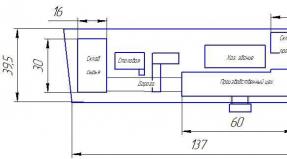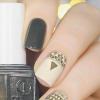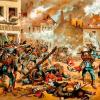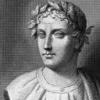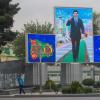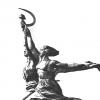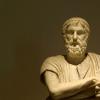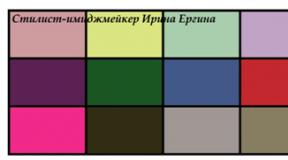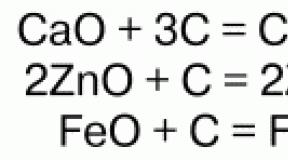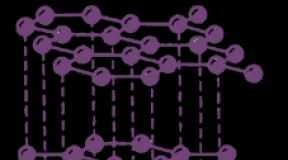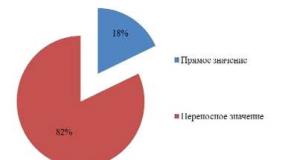Neolithic and Mediterranean race. mediterranean race mediterranean ethnic type
It was first identified by the French racial anthropologist J. Lapouge in the second half of the 19th century. G. Günther called this race Western, and V. Bunak introduces the term Pontic race to designate the Black Sea variety of the Mediterraneans.
The shape of the head of the Mediterranean race is close to the Nordic, but noticeably smaller in absolute size. The skull is dolichocephalic (or mesocephalic), the occiput protruding. The face is narrow, the brow ridges are absent, the eyes and hair are dark, the skin tone is darker than that of other European races, the facial features are “wrong”, the appearance is “southern”.
In the work “The Racial of the German People”, G. Günther describes the Mediterraneans as follows:
"Western race. Signs: small stature, long head, narrow face, chin protrudes less; narrow nose with a high base, soft brown or black hair, deep-set dark eyes, brownish skin. Deniker distinguishes between two varieties: Ibero-island and coastal or Atlanto-Mediterranean.
Sergi also calls this race Euro-African. In the writings of German authors (in particular, L.F. Klauss) the name Mediterranean race is also found, but usually, after Sergi, it is called Mediterranean. In scientific classification, the term “Homo mediterraneus” is often used, in Sergi it is a Mediterranean variety of the Euro-African species, in Lapouge it is Homo meridionalis. English researchers used to call this race Iberian, French and Italian - Ligurian. I have chosen the name "Western" race, because it indicates better than "Mediterranean" the present and prehistoric area of distribution of this race. The name "Mediterranean" race diverts our attention from the fact that people of this race also live in Scotland, southern England and Ireland. My opinion about the correctness of this choice was strengthened by the book of K. Schuchardt "Ancient Europe", 2nd edition, Berlin, 1926, in which, on the basis of archaeological finds, he showed how a civilization that arose in Western Europe on the territory of present-day England, Spain and France spread along the shores of the Mediterranean Sea.
Formation and settlement.
“Because of the characteristics common to the Nordic and Mediterranean races, we come to the postulate of the common origin of these races from the same Paleolithic group” G. Günter “Racial elements of European history”
According to K. Kuhn, most likely such a Paleolithic group was the Cro-Magnons related to the samples from Galley-Hill, Combe-Capelle and Afalu No. 26.
Part of this population of Cro-Magnons probably moved to the Middle East, while the other remained in Europe (and became the Nords, who later manifested themselves in the form of a type of corded ceramics and battle axes).
In Asia Minor, the Paleolithic Proto-Nordic/Proto-Mediterranean population mixed with local racial types (possibly derived from mixtures of earlier waves of Cro-Magnon settlement and local pre-Cro-Magnon hominids), forming one of the racial types of the large Near East race, the Orientalid type.
Birth surge in 3500-3000 BC in the Middle East leads to the expansion of the Middle East masses speaking Semitic-Hamitic languages (the term Afroasian language family is now used). The Cro-Magnon culture of North Africa (Mechtoids, (* 1) is swept away by the Near Asian invasion (on the eastern part of the North African Cro-Magnon culture, the Near Asian-Mediterranean Egyptian culture arises, (* 2). The Near Asian-Mediterranean wave of settlement reaches the Iberian Peninsula, and through it Western Europe (*3) Other waves of Afroasian (Semitic-Hamitic) peoples from the Middle East reach the Balkans and the Caucasus in the north, East Africa in the south, northern India in the east.(*4)
In the 1st millennium, the Celts (most likely the Nords), from Central Europe, move to Western Europe, partially exterminating, partially assimilating the Middle Eastern newcomers in Western Europe. As the Celtic expansion progressed, the Nordic type of the Celts was increasingly lost due to mixing, but the Asiatic-Mediterranean population also changed to Mediterranean, Dinaric and Mediterranean-Nordic.
The subsequent Nordic wave of the Germanic invasion of Western Europe will already give birth to the Celtic Nordid from this mixture.
"The Oriental race is closest to the Mediterranean race. Both races can be regarded as two different types of the same race, at least in physical terms...
... The question of the common origin of the Hamitic (Ethiopian) and Oriental races seems less difficult, if the area of origin of the first was indeed Southwest Asia, and the second, as Ungnad suggests, Southeast Europe. But, since the Oriental race is as close to the Mediterranean as it is to the Hamitic (Ethiopian), this immediately raises the question of the common origin of these three races.
Light pigmentation of Proto-Mediterraneans/Protonordids.
The appearance of light pigmentation among the Near Eastern population is most likely due to the Proto-Nordic/Proto-Mediterranean influence among the Orianthelids.
K. Kuhn, in his work "The Races of Europe", noted that the peoples of the Middle East have a noticeable light-pigmented part of the population. Rudimentary light pigmentation, K. Kuhn estimated about 25% of the total mass of Orientalid populations of Arabs and other peoples of Western Asia.
"This third racial zone stretches from Spain across the Strait of Gibraltar to Morocco, and thence across the southern Mediterranean coast to Arabia, East Africa, Mesopotamia and the Persian highlands; and also extends through Afghanistan to India...
(description of the Arabs of Yemen) hair color is black in 90% of the series; with the exception of one example of blond hair and one redhead, the rest of the group has dark brown hair. However, the beard color is black in only 75% of the group, with the remaining fourth divided into various shades of chestnut and red. 25% of brown and blond beards can be compared with 25% of light and mixed shades of eyes... ...for historical reasons, the figure of 25% in Yemen is too high to be explained only by mixing with an outside population."
(description of the population of Iraq and the coastal regions of the Persian Gulf) Hair color is predominantly dark chestnut or black, with a minority of 5% with light or reddish tints. As in Arabia, eye color is predominantly dark brown, and 25% of light mixed shades can be found. (Mesopotamian population is described)
(population of Kuwait) The hair on the head is typically black, and the beard shows shades ranging from chestnut to golden and red in one third. In this small group, a high proportion of red beards (18%) was found. Here again the usual 25% of mixed eyes are found, while the rest are mostly dark brown.
(Jews of Palestine, excluding 20th century immigrants) Modern Samaritans show more than the usual 25% partial or rudimentary light pigmentation; out of 35 people, 17 or 2/3 have black or dark brown hair on their heads, one person has blond hair, and the rest has chestnut hair. Only 7 (22%) out of 35 have black or dark brown beards, the rest have chestnut, blond and red beards. According to eye color, a third was light or mixed; the rest are equally divided between dark brown and brown."
K. Kuhn, "Races of Europe"
Racial types of the Mediterranean race.
There are three main types of Mediterranean race:
Western Mediterranean type - distributed throughout the northern coast of the Mediterranean Sea (among the Spaniards, French, Italians, Greeks). It is distinguished by finer facial features, darker pigmentation of the eyes and hair, and a more thin-walled physique. Actually this is the classic Mediterranean.
Atlanto-Mediterranean type - ubiquitous in Western Europe (in particular, France, Ireland, Portugal). It differs, first of all, in a normal-boned physique, taller stature, lighter (than the classic Mediterranean) pigmentation of the eyes and hair. The structure of the face is closest to the structure of the face of the Nordic race. Actually, this is a Mediterranean, who received significant Nordic influence during his formation.
The Pontic type is common among Bulgarians, Ukrainians, a small part of Greeks, Romanians, and is also found among Russians, Belarusians, Poles and Hungarians. K. Kuhn considered the Pontids as an Eastern European version of the Atlanto-Mediterraneans. Pontid characters occupy an intermediate position between the Atlanto-Mediterranean and Western Mediterranean types. In the Black Sea region, the Pontic variant of the Mediterranean race was formed under the influence of Oriental-Nordic mixtures from Iran. (*5)
The difference between the Mediterranean and the Oriental is based on the severity of Caucasoid features. Actually, it is the same as in Alpinid and Turanid, Eastern Baltid and Lappoid, etc.
*1) Cro-Magnons of North Africa, Mechtoids
Beginning in the 17th century, anthropologists began to put forward their own classifications of the population according to racial type. Scientists relied on the similarity of external features, that is, morphology served as the basis for research. The debate about the number of major races among anthropologists continues to this day. However, in most typological divisions there are classifications of Russian appearance.
nordids
The small Nordic race in anthropological classifications is part of the Caucasoid type. In Soviet times, they tried not to voice this term because of the ambiguity of geographical boundaries. The first to accept the Nordic theory were representatives of the ideology of racism.
The Nordic race spreads over the entire territory of Northern Europe, northwestern Russia, and Western Latvians and Estonians also belong to this type.
For the first time, the Nordic race was talked about thanks to the Russian-French anthropologist Joseph Deniker, who at the beginning of the 20th century brought thin, tall people with blond hair into a separate category. The Nordic race is characterized by blue and green eyes, dolichocephalic, that is, an oblong skull and pink skin.
Another Norwegian-born anatomist, Christian Schreiner, wrote that the northern type directly echoes the battle-axe culture, since the Nordic race is most common in central Scandinavia. But the American scientist K. Kuhn in the 30s of the twentieth century put forward a version that the Nordic race belongs to the circle of Mediterranean forms after he completed the process of depigmentation. In the appearance of people of this type, the anthropologist finds common features with the ancient representatives of the Danubian culture.
Uralides
This race occupies a worthy place between the Mongoloid and Caucasoid types. It is most widespread among the inhabitants of Western Siberia and the Volga region. Representatives of this type are characterized by dark hair, which can be either completely straight or curly. The skin is usually moderately pigmented, the eyes are brown. The main distinguishing features are considered to be a noticeable fold of the upper eyelid (epicanthus) and a flattened face shape.
Anthropologists of different times agree that the Uralids appeared during the mixing of Caucasoids and Mongoloids. In contrast to this statement, there is a theory about the mestizo origin of this type. To date, scientists are putting forward a compromise version, arguing that this race reflects the gene flow of Mongoloids and Caucasoids and at the same time undifferentiated types.
In the north of the Samara region, human remains were found, whose age is 11.55 thousand years according to the calibrated date. When examining the skull, anthropologist V.V. Bunak suggested that all the features of the ancient Ural race are inherent in it.
Baltides
It is possible to distinguish Baltids from other racial types due to the features of brachycephaly and mesocephaly. Representatives are characterized by a medium-width face, a straight nose with a thickened tip. Most representatives are distinguished by light pigmentation of the skin and hair.
Anthropologists believe that the appearance of the race is rooted in the Eastern Baltic type. Many Baltids have common features with Cro-Magnons and Alpinids. The western Baltids differ from the eastern ones in the width of their nose. For the former, it may be narrow, for others it is always wide. Representatives of the eastern Baltids are of medium height, while the western ones are much taller.
Pontids and Gorides
The Pontido type is characterized by straight eyebrows and narrow cheekbones. If you put a person in profile, then the cheekbones are noticeable, but not very pronounced. A high forehead and a narrow lower jaw, thin lips, straight hair are also distinctive features of this type. The skin is light, but perceives a tan, and swarthy pontids can also be found. The hair color is light or dark chestnut, the eyes are brown, but not almond-shaped, the palpebral fissure is straight. Thin-boned and tall, legs longer than the body. In general, the face looks thin and angular, has an elongated shape.
Among the Russians, there are also Gorids, who, according to the Swedish anthropologist Bertil Ludman, belong to the Alpids (Alpinids), who settled to the east and mixed with the Baltids. Therefore, this type is considered intermediate between the inhabitants of the Alps and the Baltic. Their features are sharper than those of the Baltids, but the pigmentation is lighter than that of the Alpids.
Russian types of appearance
If the concept of race is quite broad and sometimes covers entire countries, then the definition of "anthropological type" is much narrower. In 1959, a large-scale research project was completed - an expedition of anthropologists to all corners of Russia, which lasted 6 years. Based on the data obtained, scientists have identified 15 types characteristic of certain areas.
- The Ilmensko-Belozersky type has sharp features, a pronounced profile, growth is above average, in men a full beard. Every second out of a hundred has light eyes, and 29-40% have light-colored hair.
- The Valdai type is characterized by the same ratio of light eyes and hair to dark ones as the previous one, but the beard in men is rarer, the face is wider.
- The Western Upper Volga is similar to the Ilmenian, but the nose is straight, the hair is darker, and the beard is thicker. The fold of the upper eyelid is less common.
- Vyatka-Kama is similar to the eastern Upper Volga, the eyes and hair are dark.
- The Vologda-Vyatka type has predominantly light skin, light eyes and hair.
- The Klyazma type is tall people with a straight nose, brown eyes and blond hair.
- The central type is, one might say, the arithmetic mean for all Russian types. It has the greatest similarity with the western Upper Volga. Dark hair is found in most of the population.
- The Don-Sur type, despite its southern distribution, does not have Mongoloid features, and light eyes are found in every second person. Compared to residents of other southern regions, this type of skin is paler.
- The Middle Volga type is characterized by small face sizes, and men by a thick beard. 80% have dark hair, but 42% have a light iris.
- The steppe type is intermediate between the Don Sur and the Middle Volga.
- The Pskov-Poozersky type is very similar in appearance to the Prussians. Many people of this type have light eyes - almost 71%.
- Desno-Semey type - Transbaikal Old Believers, who were taken out at the end of the 19th century. from Belarus and Ukraine. They assimilated in Russia, but rarely intermarried with the Buryats and other peoples who surrounded them. Therefore, for the area where they lived, their appearance was contrasting - 47% of light eyes, every fourth out of a hundred had blond hair.
The Arkhangelsk type is the owners with a slightly wider nose than the Ilmen one, among them light-eyed people are more common. The beard is even thicker and the face has a more defined profile. Epicanthus is very rare.
The Eastern Upper Volga type of people is characterized by short stature, a concave back of the nose is less common, and the hair is on average darker than in the first two types.
With the expansion of globalization, the development of transport and the growth of the economic well-being of the people, the boundaries between individual races and types are increasingly blurred. Already now it is difficult to find "purely Russians" in whose family there would not be a representative of another race.
The vast majority of women are not satisfied with their appearance. Some complain about the angularity of the figure, others, on the contrary, about its excessive roundness. Those who are quite satisfied with their own physique are dissatisfied with individual facial features, skin or hair features.
But in the guise of famous actresses, singers, TV presenters, many do not notice any shortcomings. In fact, nature has awarded the unique beauty of everyone. However, not everyone knows how to emphasize their own attractiveness. To learn this art, you must first determine your type of appearance.
Appearance color type
The most famous and simple method for determining the type of appearance is a breakdown into 4 groups, each of which corresponds to a certain time of the year. This takes into account the color of the skin, eyes and hair of a woman. All shades are divided into light or dark, warm or cold.
Cold type of appearance: ashy shade of hair, light skin with a peach or blue tint, gray or blue eyes. Warm type: brown or red hair, hazel, green eyes, bronze skin tone.
Light type: natural blondes with a blurry contour of the lips and iris. Dark type: brown or black hair, well-defined lips and iris.
Type of appearance by season
Having determined your belonging to a particular season, it becomes easier to choose the right wardrobe and makeup. There are special tables in which all colors are divided into 4 groups listed below. Among them, you need to choose your range of shades and be guided by it when buying cosmetics and clothes.
summer - light, cold;
winter - dark, cold;

spring - light, warm;

autumn - dark, warm.

Types of appearance according to Kibby
At the end of the last century, the American David Kibby proposed his method of classifying the appearance of women. He developed a system that takes into account height, limb length, structural features of the skull and skeleton.
David Kibby singled out purely feminine (yin) and purely masculine (yang) features of appearance. Depending on the ratio in which they are present in one or another representative of the fair sex, her belonging to one of the 5 main types is determined.
The methodology is described in detail in a book called "Metamorphoses". This work has become a guide for many stylists, makeup artists, hairdressers and other professionals in the beauty industry.
In short, each type has the following features:
Gamines
Women of short stature, with large eyes, rounded features, narrow hips and shoulders. They are more like teenagers. They suit short, mischievous haircuts, modest makeup, thick eyebrows with perfect contours. Clothing may contain a cage, stripes, floral motifs.
romance
They have a purely feminine figure - wide hips and a thin waist. Full and soft oval of the face, delicate skin. The romantic type is characterized by medium height and blurring of contours. Such women are recommended tight-fitting clothes with an accentuated shoulder line, voluminous hairstyles and massive jewelry.
natural type
He is characterized by a squat, muscular figure, large palms and feet, straight lips, wide-set eyes. Representatives of this group should choose clothes with a straight T-shape silhouette, natural, slightly tousled hairstyles.
Classic type
Differs in regular, symmetrical and proportionate facial features. The lines of the figure are straight and slightly rounded. For women of this type, discreet makeup, strict hairstyles are suitable. Clothing should not contain bright details. Simply put, the image of a teacher or a lady is needed here, the other will look vulgar.
dramatic type
Tall, thin women, with sculpted features, thin noses and large mouths, angular and sharp. Romantic outfits and hair highlights are contraindicated for them. Clothing should have bright colors and sharp lines. Hairstyles are smooth with clear straight lines.
In addition to the main traits, there are subtypes. It is quite difficult to classify appearance according to this technique, without a certain experience. However, you can always turn to specialists. They will not only help determine belonging to a particular group, but also tell you how to choose the color of clothes and makeup according to the type of appearance.
Ethnic types of appearance
Representatives of various ethnic groups have their own characteristic features of appearance. The most significant elements of appearance, indicating belonging to one or another of them, are height, physique, face shape, eye shape and shade, skin and hair color. According to ethnic characteristics, most often determine the type of appearance of men.
The European people can be divided into the following subtypes:
Nordic
Medium or narrow nose, protruding chin, prominent nape, blond hair and eyes, thin lips, narrow jaw, average height sometimes high.
Dinaric
Lowered outer corners of the eyes, wide jaw, dark hair and eyes, easily tanned skin, tall stature.
Mediterranean
Almond-shaped eyes, dark brown or black hair, dark eyes, swarthy skin, full lips.
Celtic
Slightly inverted lower lip, straight or wavy chestnut hair, tall.
Asiatic
The Asian type of appearance is distinguished by a triangular, slightly rounded face with prominent cheekbones, a narrow slit of the eyes, small puffy lips, and straight black hair. The skin is predominantly olive in color, but can also be milky white.
Caucasian
The Caucasian type is characterized by a large nose, often with a hump, wide, often fused eyebrows, dark hair color and their rapid growth throughout the body.
Slavic (Scandinavian)
The Slavic type of appearance or Scandinavian is the same Nordic. Russians, Belarusians, Ukrainians, Poles, Bulgarians, Serbs have a Slavic appearance. Scandinavian - Norwegians, Swedes, Finns, Danes.
It was the ethnic features of appearance that became the fundamental factor in choosing the colors and styles of national costumes. No wonder even modern designers take them into account when creating modern outfits.
In continuation of the topic of ancient civilizations, I offer you a small compilation of data on the racial and ethnic history of the Hellenic world - from the Minoan era to the Macedonian expansion. Obviously, this topic is more extensive than the previous ones. Here we will dwell on the materials of K. Kuhn, Angel, Poulianos, Sergi and Ripley, as well as some other authors ...
To begin with, it is worth noting a few points related to the pre-Indo-European population of the Aegean basin.
Herodotus about the Pelasgians:
"The Athenians are of Pelasgian origin, while the Lacedomonians are of Hellenic origin"
“When the Pelasgians occupied the land that is now called Greece, the Athenians were Pelasgians and were called Kranaii; when the Cecrops ruled, they were called Cecropides; under Eret they became the Athenians and, as a result, the Ionians, from Ionus, the son of Xutus "
“... the Pelasgians spoke a barbarian dialect. And if all Pelasgi were such, then the Athenians, being Pelasgians, changed their language at the same time as all of Greece.
"The Greeks, already isolated from the Pelasgians, were few in number, and their number grew by mixing with other barbarian tribes"
“... the Pelasgians, who had already become Hellenes, united with the Athenians when they also began to call themselves Hellenes”
In the "Pelasgians" of Herodotus, it is worth considering a conglomeration of various tribes, having both autochthonous Neolithic origin, and Asia Minor, and the North Balkan origin, which passed, during the Bronze Age, the process of homogenization. Later, the Indo-European tribes who came from the north of the Balkans, as well as the Minoan colonists from Crete, were also involved in this process.
Skulls of the Middle Bronze Age:
207, 213, 208 - female skulls; 217 - male.
207, 217 – Atlanto-Mediterranean type (“basic white”); 213 – European Alpine type; 208 - Eastern Alpine type.
It is also necessary to touch upon Mycenae and Tiryns, the civilizational centers of the Middle Bronze Age.
Reconstruction of the appearance of the ancient Mycenaeans:
Paul Fort, "Daily life in Greece during the Trojan War"
“Everything that can be learned from the study of skeletons of the early Hellenic type (XVI-XIII centuries BC), with the current level of anthropological information, only confirms and slightly supplements the data of Mycenaean iconography. The men buried in the circle B of the royal tombs at Mycenae averaged 1.675 meters in height, seven were over 1.7 meters. Women - mostly 4-8 centimeters lower. In circle A, two skeletons are more or less well preserved: the first reaches 1.664 meters, the second (the bearer of the so-called mask of Agamemnon) - 1.825 meters. Lawrence Angil, who studied them, noticed that both had extremely dense bones, bodies and heads were massive. These people clearly belonged to a different ethnic type from their subjects and were on average 5 centimeters taller than them.
If we talk about the "God-born" sailors who came from across the sea and usurped power in the old Mycenaean policies, then here, most likely, we have a place with the ancient Eastern Mediterranean tribes of sailors. The "God-born" found their reflection in myths and legends, with their names began the dynasties of the Hellenic kings, who already lived in the Classical era.
Paul Fort about the type displayed on the death masks of kings from the "god-born" dynasties:
“Some deviations from the common type on the golden masks from the burial grounds allow us to see other physiognomies, one is especially interesting - almost round, with a more fleshy nose and eyebrows fused at the bridge of the nose. Such persons are often found in Anatolia, and even more often in Armenia, as if on purpose wanting to substantiate the legends, according to which many kings, queens, concubines, craftsmen, slaves and soldiers moved from Asia Minor to Greece.
Traces of their presence can be found among the populations of the Cyclades, Lesbos and Rhodes.
A. Poulianos about the Aegean Anthropological Complex:
“He stands out for dark pigmentation, wavy (or straight) hair, medium chest hair growth, above average beard growth. The influence of the Near East elements is undoubtedly evident here. According to the color and shape of the hair, according to the growth of the beard and hair on the chest in relation to the anthropological types of Greece and Western Asia, Aegean type occupies an intermediate position
Also, confirmation of the expansion of navigators "from across the sea" can be found in the data dermatology:
“There are eight types of prints, which can easily be reduced to three main ones: arcuate, looped, whorled, that is, those whose lines diverge in concentric circles. The first attempt at comparative analysis, made in 1971 by Professors Rol Astrom and Sven Erikeson on the material of two hundred copies of the Mycenaean era, turned out to be discouraging. She showed that for Cyprus and Crete the percentage of arc prints (5 and 4%, respectively) is the same as for the peoples of Western Europe, for example, Italy and Sweden; the percentage of looped (51%) and whorled (44.5%) is very close to what we see among the peoples of modern Anatolia and Lebanon (55% and 44%). True, the question of what percentage of Greek artisans were Asian emigrants remains open. And yet the fact remains: the study of fingerprints revealed two ethnic components of the Greek people - European and Middle Eastern "
Coming up to more detailed description population of ancient Hellas K. Kuhn about the ancient Hellenes(from "The Races of Europe")
“... In 2000 BC. there were, from a cultural point of view, three main elements of the Greek population: local Neolithic Mediterraneans; aliens from the north, from the Danube; Cycladic tribes from Asia Minor.
Between 2000 BC and the era of Homer, Greece was invaded three times: (a) by the Corded Ware tribes who came from the north later than 1900 BC and who, according to Myres, brought the Indo-European basis Greek language; (b) the Minoans from Crete, who gave the "ancient genealogy" to the dynasties of the rulers of Thebes, Athens, Mycenae. Most of them invaded Greece later than 1400 BC. © "God-born" conquerors, such as Atreus, Pelops, etc., who came from the Aegean on ships, learned the Greek language and usurped the throne, marrying the daughters of the Minoan kings ... "
“The Greeks of the great period of the Athenian civilization were the result of a mixture of various ethnic elements, and the search for the origins of the Greek language continues ...”
“The skeletal remains should come in handy in the process of reconstructing history. The six skulls from Ayas Kosmas, near Athens, represent the entire period of mixing of Neolithic, "Danubian" and "Cycladic" elements, between 2500 and 2000 BC. BC. Three skulls are dolichocephalic, one is mesocephalic, and two are brachycephalic. All faces are narrow, noses are leptorrhine, orbits are high ... "
“The Middle Helladic period is represented by 25 skulls, which represent the era of the invasion of the Corded Ware culture from the North, and the process of strengthening the power of the Minoan conquerors from Crete. 23 skulls are from Asin, and 2 are from Mycenae. It should be noted that the population of this period are very mixed. Only two skulls are brachycephalic, they are both male and both are associated with short stature. One skull is of medium size, high skull, narrow nose and narrow face; others are extremely broad-faced and Hamerrin. They are two different broad-headed types, both of which can be found in present-day Greece.
Long skulls are not a homogeneous type; some have large skulls and massive brows, with deep nasal cavities, reminiscent to me of a variant of the Neolithic dolichocephals from Long Barrow and the Corded Ware culture…”
“The rest of the dolichocephalic skulls represent the Middle Helladic population, which had smoothed eyebrows and long noses, similar to the inhabitants of Crete and Asia Minor in the same era ...”
“...41 skulls of the late Helladic period, dated between 1500 and 1200. BC, and having their origin, for example, from Argolis, must include a certain element of "God-born" conquerors. Among these skulls, 1/5 are brachycephalic, mostly of the Cypriot Dinaric type. Among the dolichocephalic, a significant proportion are difficult-to-classify variants, and a smaller number are undersized Mediterranean variants. The similarity with the northern types, with the type of Corded Ware culture in particular in this era seems to be more noticeable than before. This change of non-Minoan origin must be related to the heroes of Homer"
“... The racial history of Greece in the classical period is not described in as much detail as in those periods that were previously studied. Up to the beginning of the slave era, there may have been small population changes. In the Argolis, the pure Mediterranean element is present in only one of the six skulls. According to Kumaris, mesocephaly dominated Greece throughout the Classical period, both in the Hellenistic and Roman eras. The average cephalic index in Athens, represented by 30 skulls, of this period is 75.6. Mesocephaly displays a mixture of various elements, among which the Mediterranean is dominant. Greek colonies in Asia Minor display the same combination of types as in Greece. The mixture with Asia Minor was supposed to be masked by a noticeable similarity between the populations of both shores of the Aegean Sea"
“The high-bridged Minoan nose and lithe body came to classical Greece as an artistic ideal, but human portraits show that this could not have been commonplace in life. Villains, funny characters, satyrs, centaurs, giants and all objectionable people both in sculpture and in vase painting are shown as broad-faced, snub-nosed and bearded. Socrates belonged to this type, similar to a satyr. This Alpine type can also be found in modern Greece. And in the early skeletal materials, it is represented by some brachycephalic series.
In general, it is surprising to contemplate the portraits of the Athenians and the death masks of the Spartans, so similar to the modern inhabitants of Western Europe. This similarity is less noticeable in Byzantine art, where one can often find images similar to modern inhabitants of the Middle East; but the Byzantines, in the main, lived outside of Greece.
As will be shown below(Chapter XI) , the modern inhabitants of Greece, oddly enough, practically do not differ from their classical ancestors»
Greek skull from Megara:
The following data leads Lauren Angel:
“All evidence and assumptions contradict Nilsson's hypothesis that the Greco-Roman decline is associated with an increase in the reproduction of passive individuals, the bastardization of the originally racially pure nobility, as well as their low birth rate. Since it was this mixed group, which appeared in the Geometric period, that gave rise to the Classical Greek civilization"
Analysis of the remains of representatives of different periods of Greek history, reproduced by Angel:
Based on the above data, the dominant elements in the Classical era are: Mediterranean and Iranian-Nordic.
Greeks of the Iranian-Nordic type(from the works of L. Angel)
“Representatives of the Iranian-Nordic type have long, high craniums with strongly protruding occiputs that smooth out the contour of an ovoid ellipsoid, developed eyebrows, sloping and wide foreheads. Considerable height of the face and narrow cheekbones, combined with a wide jaw and forehead, give the impression of a rectangular "horse" face. Large but compressed cheekbones are combined with high orbits, an aquiline protruding nose, a long concave palate, massive wide jaws, chins with a recess, although not protruding forward. Initially, representatives of this type were both blue-eyed and green-eyed blondes and brown-haired, and burning brunettes.
Greeks of the Mediterranean type(from the works of L. Angel)
“Classic Mediterraneans are thin-boned and gracile. They have small dolichocephalic heads, pentagonal in vertical and occipital projection; contracted neck muscles, low rounded foreheads. They have delicate beautiful features; square orbits, thin noses with a low nose bridge; triangular mandibles with a slight protruding chin, barely noticeable prognathism and malocclusion, which is associated with the degree of wear of the teeth. Initially, they were only below average height, with a thin neck, brunettes with black or dark hair.
Having studied the comparative data of the ancient and modern Greeks, Angel draws conclusions:
"racial continuity in Greece is striking"
“Poulianos is correct in his judgment that there is a genetic continuity of the Greeks from antiquity to modernity”
For a long time, the question of the influence of the northern Indo-European elements on the genesis of the Greek civilization remained debatable, so it is worth dwelling on a few points related to this particular topic:
The following writes Paul Fort:
“Classical poets, from Homer to Euripides, stubbornly draw heroes tall and blond. Any sculpture from the Minoan era to the Hellenistic era endows goddesses and gods (except perhaps Zeus) with golden curls and superhuman growth. It is rather an expression of an ideal of beauty, a physical type not found among mere mortals. And when the geographer Dikearchus from Messene in the 4th century BC. e. surprised at the blond Thebans (dyed? red?) and praises the courage of the fair-haired Spartans, he only emphasizes in this way the exceptional rarity of blondes in the Mycenaean world. And in fact, on the few images of warriors that have come down to us - - be it ceramics, inlay, wall paintings of Mycenae or Pylos. we see men with black, slightly curly hair, and their beards, if any, are as black as agate. No less dark are the wavy or curly hair of priestesses and goddesses in Mycenae and Tiryns. Wide-open dark eyes, a long thin nose with a clearly marked, and even fleshy tip, thin lips, very fair skin, relatively small stature and a slender figure - all these features we invariably find on Egyptian monuments where the artist sought to capture "peoples that live on the islands of the Great (Substantial) Green. In the XIII, as in the XV century BC. e., most of the population of the Mycenaean world belonged to the oldest Mediterranean type, the same one that has been preserved in many regions to this day "
L. Angel
"there is no reason to suppose that the Iranian-Nordic type in Greece was as light-pigmented as the Nordic type in northern latitudes"
J. Gregor
“... Both the Latin “flavi”, and the Greek “xanthos”, and “hari” are generalized terms with many additional meanings. "Xanthos", which we boldly translate as "blonde", was used by the ancient Greeks to define "any color of hair except jet black, and that color was in all probability no lighter than dark chestnut" ((Weiss, Keiter ) Sergi)…”
K. Kuhn
"... we cannot be sure that all prehistoric skeletal material that appears to be north-Caucasian in the osteological sense was associated with light pigmentation"
Buxton
“With regard to the Achaeans, we can say that there seems to be no reason to suspect the presence of a North Caucasian component”
Debets
“In the composition of the population of the Bronze Age, we generally find the same anthropological types as in the modern population, only with a different percentage of representatives of one type or another. We can't talk about mixing with the northern race."
K. Kuhn, L. Angel, Baker and, later, Aris Poulianos were of the opinion that the Indo-European language was brought to Greece along with the ancient tribes of Central Europe, which, as an integral element, became part of the Dorian and Ionian tribes that assimilated the local Pelasgian population.
We can find indications of this fact in the ancient author Polemona(living in the era of Hadrian):
“Those who managed to preserve the Hellenic and Ionian race in all its purity (!) are quite tall, broad-shouldered, stately, well-cut and rather fair-skinned men. Their hair is not quite light (that is, light brown or light brown), relatively soft and slightly wavy. The faces are broad, high cheekbones, the lips are thin, the nose is straight and shiny, full of fire, eyes. Yes, the eyes of the Greeks are the most beautiful in the world.
These features: a strong physique, medium or tall height, mixed hair pigmentation, wide cheekbones indicate a Central European element. Similar data can be found in Poulianos, according to the results of his research, the Central European Alpine type in some regions of Greece has a specific gravity of 25-30%. Poulianos studied 3,000 people from various regions of Greece, among which Macedonia is the most light-pigmented, but at the same time, the cephalic index there is 83.3, i.e. an order of magnitude higher than in all other regions of Greece. In northern Greece, Poulianos distinguishes the Western Macedonian (North-Pindian) type, it is the most light-pigmented, is sub-brachycephalic, but at the same time, it is similar to the Helladic anthropological group (Central Greek and South Greek type).
As a more or less illustrative example West Macedonian complex damn - Bulgarian-speaking Macedonian:
An interesting example is the fair-haired characters from pellets(Macedonia)
In this case, the heroes are depicted as golden-haired, pale (as opposed to mere mortals working under the scorching sun?), very tall, with a straight profile line.
In comparison with them - image detachment of hypaspists from Macedonia:
On the image of the heroes, we see the underlined sacredness of their image and features, which are as different as possible from the "mere mortals" embodied in the hypaspist warriors.
If we talk about paintings, then the relevance of their comparison with living people is doubtful, since the creation of realistic portraits begins only from the 5th-4th century. BC. - before this period, the image of features that are relatively rare among people dominates (an absolutely straight line of the profile, a heavy chin with a soft contour, etc.).
However, the combination of these features is not a fantasy, but an ideal, the models for the creation of which were few. Some parallels for comparison:
In the 4th-3rd centuries. realistic images people are starting to become widespread – some examples are:
Alexander the Great(+proposed face reconstruction)
Alcibiades / Thucydides / Herodotus
On the sculptures of the era of Philip Argeada, the conquests of Alexander and in the Hellenistic period, which are distinguished by a higher realism than in earlier periods, dominates atlanto-mediterranean(“basic white” in Angel's terminology) type. Perhaps this is an anthropological pattern, and possibly a coincidence or a new ideal, under which the features of the depicted personalities were summed up.
Atlanto-Mediterranean characteristic of the Balkan Peninsula:
Modern Greeks of the Atlanto-Mediterranean type:
Based on the data of K. Kuhn, the Atlanto-Mediterranean substrate is to a large extent present in Greece everywhere, and is also the basic element for the populations of Bulgaria and Crete. Angel also positions this anthropological element as one of the most prevalent in the population of Greece, both throughout history (see table) and in the modern era.
Antique sculptural images showing features of the above type:
The same features are clearly visible in the sculptures of Alcibiades, Seleucus, Herodotus, Thucydides, Antiochus and other representatives of the Classical era.
As mentioned above, this element also dominates among population of Bulgaria:
2) Tomb in Kazanlak(Bulgaria)
The same features are visible here as in the previous paintings.
Thracian type according to Aris Poulianos:
"Of all the types of the southeastern branch of the Caucasoid race Thracian type the most mesocephalic and narrow-faced. The profile of the bridge of the nose is straight or convex (often concave in women). The position of the tip of the nose is horizontal or raised. The slope of the forehead is almost straight. The protrusion of the wings of the nose and the thickness of the lips are medium. In addition to Thrace and eastern Macedonia, the Thracian type is common in Turkish Thrace, in the west of Asia Minor, partly among the population of the Aegean Islands and, apparently, in the north, in Bulgaria (in the southern and eastern regions). This type is closest to the central one, especially to its Thessalian variant. It can be opposed to both Epirus and Western Asian types, and is called southwestern ... "
Both Greece (with the exception of Epirus and the Aegean archipelago), as a zone of localization of the civilizational center of the Classical Hellenic civilization, and Bulgaria, with the exception of the northwestern regions, as the ethnic core of the ancient Thracian community), are relatively tall, darkly pigmented, mesocephalic, high-headed populations, whose specificity fits into the framework of the Western Mediterranean race (see Alekseev).
Map of peaceful Greek colonization in the 7th-6th centuries. BC.
During the expansion of the 7th-6th centuries. BC. Greek colonists, leaving the overpopulated cities of Hellas, brought the grain of classical Greek civilization to almost all parts of the Mediterranean: Asia Minor, Cyprus, Southern Italy, Sicily, the Black Sea coast of the Balkans and Crimea, as well as the emergence of a few policies in the Western Mediterranean (Massilia, Emporia, etc. .d.).
In addition to the cultural element, the Hellenes brought there the "grain" of their race - a genetic component isolated Cavalli Sforza and associated with areas of the most intensive colonization:
This element is also visible clustering of the population of South-Eastern Europe by Y-DNA markers:
Concentration of various Y-DNA markers in the population of modern Greece:
Greeks N=91
15/91 16.5% V13 E1b1b1a2
1/91 1.1% V22 E1b1b1a3
2/91 2.2% M521 E1b1b1a5
2/91 2.2% M123 E1b1b1c
2/91 2.2% P15(xM406) G2a*
1/91 1.1% M406 G2a3c
2/91 2.2% M253(xM21,M227,M507) I1*
1/91 1.1% M438(xP37.2,M223) I2*
6/91 6.6% M423(xM359) I2a1*
2/91 2.2% M267(xM365,M367,M368,M369) J1*
3/91 3.2% M410(xM47,M67,M68,DYS445=6) J2a*
4/91 4.4% M67(xM92) J2a1b*
3/91 3.2% M92 J2a1b1
1/91 1.1% DYS445=6 J2a1k
2/91 2.2% M102(xM241) J2b*
4/91 4.4% M241(xM280) J2b2
2/91 2.2% M280 J2b2b
1/91 1.1% M317 L2
15/91 16.5% M17 R1a1*
2/91 2.2% P25(xM269) R1b1*
16/91 17.6% M269 R1b1b2
4/91 4.4% M70 T
The following writes Paul Faure:
“For several years, a group of scientists from Athens - V. Baloaras, N. Konstantoulis, M. Paidusis, X. Sbarunis and Aris Poulianos - studying the blood groups of young conscripts of the Greek army and the composition of bones burned at the end of the Mycenaean era, came to a double conclusion about that the Aegean Sea basin shows a striking uniformity in the ratio of blood types, and a few exceptions, recorded, say, in the White Mountains of Crete and in Macedonia, find a match among the Ingush and other peoples of the Caucasus (while throughout Greece the blood type is “B "approaches 18%, and the group "O" with slight fluctuations - to 63%, here they are noted much less often, and the latter sometimes drops to 23%). This is a consequence of ancient migrations within the stable and still predominant Mediterranean type in Greece "
Y-DNA markers in the population of modern Greece:
mt-DNA markers in the population of modern Greece:
Autosomal markers in the population of modern Greece:
AS A CONCLUSION
It is worth making several conclusions:
Firstly, Classical Greek civilization, formed in the 8th-7th centuries. BC. included a variety of ethno-civilizational elements: Minoan, Mycenaean, Anatolian, as well as the influence of the North Balkan (Achaean and Ionian) elements. The genesis of the civilizational core of Classical civilization is a set of processes of consolidation of the above elements, as well as their further evolution.
Secondly, the racial genetic and ethnic core of the Classical civilization was formed as a result of the consolidation and homogenization of various elements: Aegean, Minoan, North Balkan and Anatolian. Among which the dominant was the autochthonous East Mediterranean element. The Hellenic "core" was formed as a result of complex processes of interaction between the above elements.
Thirdly, unlike the "Romans", who were essentially a polytonym ("Roman = citizen of Rome"), the Hellenes formed a unique ethnic group that retained a family relationship with the ancient Thracian and Asia Minor population, but became the racial genetic basis for a completely new civilization. Based on the data of K. Kuhn, L. Angel and A. Poulianos, there is a line of anthropological continuity and “racial continuity” between modern and ancient Hellenes, which manifests itself both in comparison between populations as a whole, as well as in comparison between specific micro-elements.
Fourth, despite the fact that many people have an oppositional opinion, the Classical Greek civilization became one of the bases for the Roman civilization (along with the Etruscan component), thereby partly predetermining the further genesis of the Western world.
Fifth, in addition to influencing Western Europe, the era of the campaigns of Alexander and the wars of the Diadochi was able to give rise to a new Hellenistic world, in which various Greek and Oriental elements were closely intertwined. It was the Hellenistic world that became fertile ground for the emergence of Christianity, its further spread, as well as the emergence of the Eastern Roman Christian civilization.
You can soak up the Sun at any time of the year: our planet exposes it to one or the other side. Sunbathing will benefit your appearance and well-being if you prepare carefully for them: find out more about the place of rest and what sun protection products are right for you. To do this, take a test that helps determine skin phototypes
Human skin phototypes depend on the activity of melanocytes: skin cells responsible for the synthesis of the pigment melanin, which protects the skin from sunburn and gives it a bronze color.
Celtic skin type
Celtic skin type occurs in the Scots, Irish and Scandinavians. The Celtic type of appearance and skin phototype is quite simple to determine: delicate light skin, often strewn with freckles. In such skin, melanin is practically not formed, so the skin instantly burns, turns red, but does not even think about sunbathing in the sun.
Nordic type of appearance
The Nordic skin type is found in the inhabitants of Siberia and central Russia, Northern Europe and Canada. The Nordic type of appearance is easily recognizable by light, pale pink skin and light blond, sometimes reddish hair. Such skin also does not have enough melanin, so before properly sunbathing in the sun, get a sunscreen.
Central European skin type
The European type of skin prevails in the south of Russia, and also in Central and Eastern Europe. This is dark skin, light brown or brown hair, light eyes. This skin phototype contains more melanin than the previous ones, but they still need sun protection products.
Mediterranean skin type
The Mediterranean skin type is found in the inhabitants of the Caucasus, Central Asia, the Mediterranean coast of Europe. Signs of a person with such skin: dark hair, brown or dark brown eyes and dark skin, which is not very sensitive to ultraviolet rays. Therefore, in this case, moderately required means for sun protection, and sunscreen for the face is generally of little demand.
Southern skin type
The southern type of skin prevails among mulattos, residents of the Middle East and Arab countries, India and South America. The skin is dark or very dark. Hair black, blue-black. The eyes are dark brown. The southern skin type is rich in melanin, so sunscreen is practically not needed.
African skin type
Found in Africans and African Americans. The skin is black, the hair is black, curly, the eyes are dark brown. They never burn, so they do not need sunscreen.
How to sunbathe in the sun and the sea?
In order to understand how to properly sunbathe at sea, take this test. The time indicated in the test results will help to increase the face and body sunscreen with a light protection filter. When you buy a cream, the sun protection on the packaging is listed in numbers, such as "Sunscreen spf 50". (By the way, "Sunscreen spf 50" is the most powerful sunscreen ever.) Now you need to multiply this by the amount of time your body's natural sun protection is active, as determined by the test. As a result, we understand how to properly sunbathe in the sun and the sea. That is - if your natural sun protection is 10 minutes and your sunscreen has a rating of -25, that is, with a rating of 6, that is, spf 25, you only need to multiply 10 by 25, which will be 250 minutes or three hours and 10 minutes.


